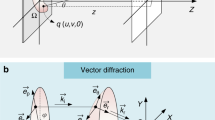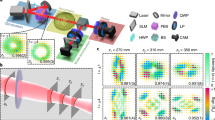Abstract
It may be desirable to represent optical fields using scalar approximations, due to its simplicity. Since the optical field is an electromagnetic wave, in order to implement an optical setup, a mapping from such a scalar field to the vector electromagnetic field is needed. In the conventional scalar-to-vector field mapping, a large error in power spectrum arises in wide-angle fields due to the neglected large longitudinal component of the electric field. This error could be severe in wide-angle or off-axis imaging setups. In order to find another scalar-to-vector field mapping that compensates for this large magnitude error, first, a general constraint on monochromatic electromagnetic fields to appropriately represent them by a scalar wave in free space is developed. The development of the general constraint begins by formulating the computations of the components of the magnetic field as the outputs of linear-shift invariant (LSI) systems, where the inputs to the LSI systems are the transverse components of the electric field. Furthermore, if one of the transverse components of the electric field can be computed from the other one using a LSI operation, a scalar field, which is related to the transverse components through another LSI system, can be used to fully describe the electromagnetic field. Under this constraint, the required condition on the filters which relates the scalar field to the electric field is presented by taking into consideration the longitudinal component, such that the power spectra of the scalar field and the corresponding electric field are equal. The filters are specified for the electric fields with zero longitudinal component and simple polarization features, as well. Moreover, for the electric fields with simple polarization features, some discrete simulations are performed to compare the scalar field intensity pattern and the corresponding electric field intensity patterns for the conventional and proposed mapping cases. The simulation results show that the excessive amplification of the large frequency components is compensated by the proposed filters, and hence, the undesired effects of the filters used in the computation of the longitudinal component disappear. In this respect, if equality of the power spectra of the scalar field and the corresponding electric field is of concern in an application, the proposed scalar-to-vector wave field mapping should be used.






Similar content being viewed by others
References
Andrews, H.C., Hunt, B.R.: Digital Image Restoration. Prentice-Hall Inc., New Jersey (1977)
Balanis, C.A.: Antenna Theory: Analysis and Design. Wiley, New Jersey (2005)
Borgiotti, G.: Fourier transforms method in aperture antennas problems. Alta Frequenza 32, 196–204 (1963)
Born, M., Wolf, E.: Principles of Optics: Electromagnetic Theory of Propagation, Interference and Diffraction of Light. Cambridge University Press, Cambridge (1999)
Bouwkamp, C.J.: Diffraction theory. Rep. Prog. Phys. 17, 35–100 (1954)
Cannon, T.M.: Digital image deblurring by nonlinear homomorphic filtering. Ph.D. thesis, Computer Science Department, University of Utah (1974)
Delen, N., Hooker, B.: Free-space beam propagation between arbitrarily oriented planes based on full diffraction theory: a fast Fourier transform approach. J. Opt. Soc. Am. A 15, 857–867 (1998)
Erdélyi, A., Magnus, W., Oberhettinger, F.: Tables of Integral Transforms. McGraw-Hill, New York (1954)
Esmer, G.B.: Computation of holographic patterns between tilted planes. Master’s thesis, Bilkent University (2004)
Esmer, G.B., Onural, L., Ozaktas, H.M.: Exact diffraction calculation from fields specified over arbitrary curved surfaces. Opt. Commun. 284, 5537–5548 (2011)
Esmer, G.B., Uzunov, V., Onural, L., Ozaktas, H.M., Gotchev, A.: Diffraction field computation from arbitrarily distributed data points in space. Signal Process. Image Commun. 22, 178–187 (2007)
Gabor, D.: A new microscopic principle. Nature 161, 777–778 (1948)
Geng, J.: Three-dimensional display technologies. Adv. Opt. Photon. 5, 456–535 (2013)
Goodman, J.W.: Introduction to Fourier Optics. McGraw-Hill, New York (1996)
Grigoryan, A.M., Doughelly, E.R.: Optimization of linear filters under power-spectral-density stabilization. IEEE Trans. Signal Process. 49, 2292–2300 (2001)
Grigoryan, A.M., Dougherty, E.R., Agaian, S.S.: Optimal Wiener and homomorphic filtration: review. Signal Process. 121, 111–138 (2016)
Kong, J.A.: Electromagnetic Wave Theory. Wiley, New Jersey (1986)
Kulce, O., Onural, L., Ozaktas, H.M.: Evaluation of the validity of the scalar approximation in optical wave propagation using a systems approach and an accurate digital electromagnetic model. J. Mod. Opt. 63, 2382–2391 (2016)
Leith, E.N., Upatnieks, J.: Reconstructed wavefronts and communication theory. J. Opt. Soc. Am. 52, 1123–1130 (1962)
Lueder, E.: 3D Displays. Wiley, New York (2012)
Luneburg, R.K., Herzberger, M.: Mathematical Theory of Optics. University of California Press, Los Angeles (1964)
Onural, L.: Some mathematical properties of the uniformly sampled quadratic phase function and associated issues in digital Fresnel diffraction simulations. Opt. Eng. 43, 2557–2563 (2004)
Onural, L., Yaras, F., Kang, H.: Digital holographic three-dimensional video displays. Proc. IEEE 99, 576–589 (2011)
Oppenheim, A.V., Schafer, R.W., Buck, J.R.: Discrete-Time Signal Processing. Prentice Hall, New Jersey (1999)
Osten, S., Krüger, S., Steinhoff, A.: Spatial light modulators based on reflective micro-displays. Tech. Mess. 73, 149–156 (2006)
Rhodes, D.: On the stored energy of planar apertures. IEEE Trans. Antennas Propag. 14, 676–683 (1966)
Şahin, E., Onural, L.: Scalar diffraction field calculation from curved surfaces via Gaussian beam decomposition. J. Opt. Soc. Am. A 29, 1459–1469 (2012)
Şahin, E., Onural, L.: Calculation of the scalar diffraction field from curved surfaces by decomposing the three-dimensional field into a sum of Gaussian beams. J. Opt. Soc. Am. A 30, 527–536 (2013)
Sherman, G.C.: Application of the convolution theorem to Rayleigh’s integral formulas. J. Opt. Soc. Am. 57(4), 546–547 (1967)
Theimer, O., Wassermann, G.D., Wolf, E.: On the foundation of the scalar diffraction theory of optical imaging. Proc. Roc. Soc. A 212, 426–437 (1952)
Yaras, F., Kang, H., Onural, L.: State of the art in holographic displays: a survey. J. Disp. Technol. 6, 443–454 (2010)
Yeh, P., Gu, C.: Optics of Liquid Crystal Displays. Wiley, New York (1999)
Author information
Authors and Affiliations
Corresponding author
Additional information
Onur Kulce acknowledges partial support of TÜBİTAK for this work in the form of a scholarship.
Rights and permissions
About this article
Cite this article
Kulce, O., Onural, L. Power Spectrum Equalized Scalar Representation of Wide-Angle Optical Field Propagation. J Math Imaging Vis 60, 1246–1260 (2018). https://doi.org/10.1007/s10851-018-0813-1
Received:
Accepted:
Published:
Issue Date:
DOI: https://doi.org/10.1007/s10851-018-0813-1




